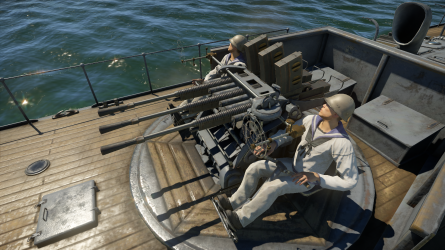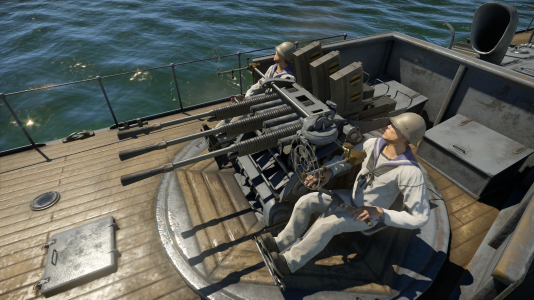25 mm/60 Type 96 (25 mm)
| This page is about the Japanese naval cannon 25 mm/60 Type 96 (25 mm). For other uses, see Type 96 (Disambiguation). |

Contents
Description
The Type 96 cannon is a 25 mm naval anti-aircraft automatic cannon that can be found on many WWII-era motor torpedo boats, sub-chasers, destroyers and light cruisers throughout the Japanese naval tech tree, in either single, double, or triple mounts.
Vehicles equipped with this weapon
| Vehicles equipped with this weapon | |
|---|---|
| Motor torpedo boats | Type T-14 (mod. 1) · Type T-38 · Type T-51a · Type T-51b |
| Gunboats | Chidori |
| Sub-chasers | Type K-3 No.1 · Type K-7 No.4 · Type K-8 No.13 late |
| Frigates | Syonan |
| Destroyers | IJN Akizuki · IJN Hatsuzuki · IJN Hayanami · IJN Kiyoshimo · IJN Nenohi · IJN Shimakaze · IJN Yugumo |
| Light cruisers | IJN Agano · IJN Isuzu · IJN Tama · IJN Mikuma · IJN Sendai · IJN Suzuya · IJN Yubari |
| Heavy cruisers | IJN Aoba · IJN Furutaka · IJN Mogami · IJN Myoko · IJN Haguro · IJN Tone |
| Battleships | IJN Fuso · IJN Haruna · IJN Ise · IJN Kongo |
General info
The Type 96 has a barrel diameter of 25 mm, a barrel length of 1.500 m, and weighs 115 kg. It has a magazine size of 15 rounds and a rate of fire of 261 rounds per minute.
Available ammunition
Depending on the vehicle, there are up to three belts available. Note that Default and Universal refer to the same belt, depending on the vehicle.
- Default/Universal: HEF-T* · HEF · AP-T · HEI
- 25 mm APT belt: AP-T · AP-T · AP-T · HEF
- 25 mm HEIT belts: HEF-T* · HEI · HEI · HEI
| Not all belts listed are available on all vehicles equipped with this weapon. |
| Penetration statistics | |||||||
|---|---|---|---|---|---|---|---|
| Ammunition | Penetration @ 0° Angle of Attack (mm) | ||||||
| 10 m | 100 m | 500 m | 1,000 m | 1,500 m | 2,000 m | ||
| HEF-T* | 2 | 2 | 2 | 2 | 2 | 2 | |
| HEI | 2 | 2 | 2 | 2 | 2 | 2 | |
| HEF | 2 | 2 | 2 | 2 | 2 | 2 | |
| AP-T | 55 | 53 | 43 | 33 | 25 | 19 | |
| Shell details | ||||||||||||
|---|---|---|---|---|---|---|---|---|---|---|---|---|
| Ammunition | Velocity (m/s) |
Projectile mass (kg) |
Fuse delay (m) |
Fuse sensitivity (mm) |
Explosive mass (TNT equivalent) (g) |
Ricochet | ||||||
| 0% | 50% | 100% | ||||||||||
| HEF-T* | 900 | 0.24 | 0 | 0.1 | 8.5 | 79° | 80° | 81° | ||||
| HEI | 900 | 0.26 | 0 | 0.1 | 5.52 | 79° | 80° | 81° | ||||
| HEF | 900 | 0.25 | 0 | 0.1 | 23.93 | 79° | 80° | 81° | ||||
| AP-T | 900 | 0.28 | - | - | - | 47° | 60° | 65° | ||||
Comparison with analogues
The closest comparison with the Type 96 calibre and penetration performance-wise is the Oerlikon Mk.II (20 mm) and its derivatives. However, the Oerlikon Mk.II is notably superior with a rate of fire over 70% greater at 450 rounds/min, as well as belt size of 60 rounds, four times as great as the Type 96. It also has a explosive mass in its HE shells over twice as much as that of the Type 96. The German equivalent, MG C/38 (20 mm) in various mountings, takes this difference even further with an explosive mass over three times as large. However, unlike both of these, the Type 96 has access to a belt containing only HE rounds, the 25 mm HEIT belt.
Among destroyer and cruiser anti-aircraft armament, the Bofors L/60 Mark 1 (40 mm) and its derivatives are vastly superior, firing a much larger projectile and having a much longer effective range, as well as being able to continuously fire without needing to reload (so long as the gun doesn't overheat).
Usage in battles
On vessels with only a single installation, the low capacity of the magazine and relatively low explosive mass in the HE rounds can be a major disadvantage, as it can potentially take multiple reloads to finish off a single enemy, whereas similar weapons can destroy their target with ammunition left to spare. Despite its deficiencies single installations, on vessels with multiple installations such as the sub-chaser Syonan and the destroyer IJN Akizuki, their potential effectiveness begins to show. On these vessels, the Type 96 cannons can provide virtually continuous fire with their relatively quick reload, other guns firing as one reloads. Together, they also overcome their small explosive mass through sheer volume of fire, making quick work of any PT boats. As anti-aircraft weapons though, they leave much to be desired, with an effective range of only about 2.5 km.
The primary belt against aircraft and enemy boats should be the 25 mm HEIT belt, since it contains purely HE rounds. That being said, several 25 mm APT belts should be carried for the occasional armoured boat. On destroyers and cruisers, there is no advantage to using the 25 mm APT belt, since armoured targets will possess more armour than they can penetrate.
Pros and cons
Pros:
- Relatively quick reload
- HEIT belt contains only HE
Cons:
- Small magazine size, 15 rounds
- Slow rate of fire
- Small explosive mass, low damage output
- Lacking AA capabilities due to low effective range
History
Beginning in 1935, Japan began to search for a replacement for the 40 mm/62 "HI" Type 91 anti-aircraft cannon, a Japanese-built Vickers QF 2-pounder "pom-pom" cannons. Eventually, the search led Japanese weapons engineers to France where the 25 mm Hotchkiss gun was selected, with a small order being placed for testing in Japan. These French-made units, designated Type 94 and Type 95, would be at Yokosuka Naval Arsenal, with the production variant, Type 96, entering mass production in Japan the same year.
The Type 96 had a barrel diameter of 25 mm (1 inch), a barrel length of 1.5 m (60 calibre), weighed 115 kg, and fired rounds with a muzzle velocity of 900 m/s. A rate of fire of 260 rounds per minute was possible, though the rate of fire was most commonly set around 220 rounds per minute, lower in elevated positions as the position interfered with spent cartridge ejection. The Type 96 was fed by a box magazine with a capacity of 15 rounds, with high explosive, high explosive incendiary, armour-piercing, and tracer rounds available. The Japanese made several modifications to the original French design, incorporating a Rheinmetall flash suppressor design, substituting forged metal components with cast metal, and using stainless steel components for use on submarines. The Type 96 was gas-operated and had an air-cooled, monobloc barrel. The barrel was replaceable, although change-outs were difficult.
The Type 96 could be mounted in single, double, and triple mounts, typically operated by three, seven, and nine crew members, respectively. The single, double, and triple mounts weighed 785 kg, 1,100 kg, and 1,800 kg, respectively. All mountings were manually laid (though some triple mounts on certain ships received electric drive systems), and ammunition was carried to the gun by the crew and manually hand loaded. The Type 96 most commonly did not have a gun shield.
Entering service in 1936, the Type 96 was very widely used throughout the Imperial Japanese Navy, mounted on almost all ships during WWII. Some guns were even used in the anti-tank role, thought its use in this role is questionable. The Japanese considered the Type 96 to be an excellent anti-aircraft cannon; however, compared to its Allied contemporaries, the Type 96 was rather lacklustre. The small magazine size of only 15 rounds meant frequent reloads which lowered its effective rate of fire to around 120 rounds per minute. The gun was also manually traversed and often couldn't be trained quickly enough to track enemy aircraft. In total, around 33,000 Type 96 guns were produced.
Media
- Images
Triple-mount on the T-51b motor torpedo noat
Single-mount on the Type K-8 No.13 late sub-chaser
Single-mount on the Type K-3 No.1 sub-chaser
- Videos
See also
External links
| Japan naval cannons | |
|---|---|
| 20 mm | JM61 · Type 98 |
| 25 mm | 25 mm/60 Type 96 |
| 37 mm | Type 4 · Type 11 pattern 1922 |
| 40 mm | 40 mm/62 Vickers |
| 57 mm | Type 97 |
| 75 mm | Type 88 AA |
| 76 mm | 3-inch/40 Type 41 · 8 cm/40 3rd Year Type · 8 cm/60 Type 98 |
| 100 mm | 100/65 mm Type 98 mod A |
| 120 mm | 120 mm/45 3rd Year Type · 120 mm/45 10th year type |
| 127 mm | 5 inch/40 Type 89 · 127 mm/50 3rd Year Type |
| 140 mm | 140 mm/50 3rd Year Type |
| 152 mm | 6-inch/45 Type 41 · 15 cm/50 Type 41 |
| 155 mm | 155 mm/60 3rd Year Type |
| 200 mm | 20 cm 3rd year type No.1 |
| 203 mm | 20 cm/45 Type 41 · 20 cm/50 3rd year type No.2 |
| 356 mm | 36 cm/45 Type 41 |
| 410 mm | 410 mm/45 Type 3 |
| Foreign: | |
| 20 mm | 20 mm/70 Oerlikon Mk.II (USA/Britain) |
| 40 mm | Bofors L/60 Mark 1 (USA) · Bofors L/60 Mark 2 (USA) · Bofors L/60 Mark 3 (USA) |
| 47 mm | 3 pdr QF Hotchkiss (Britain) |
| 76 mm | 3-inch Mark 10 (USA) · 3 inch Mk.33 (USA) · 3-inch Mk.34 (USA) |
| 120 mm | 4,7-inch/40 Armstrong (Britain) |
| 127 mm | 5 inch/38 Mk.12 (USA) |
| 305 mm | 12-inch/45 Vickers (Britain) · 12-inch/50 Vickers (Britain) |






